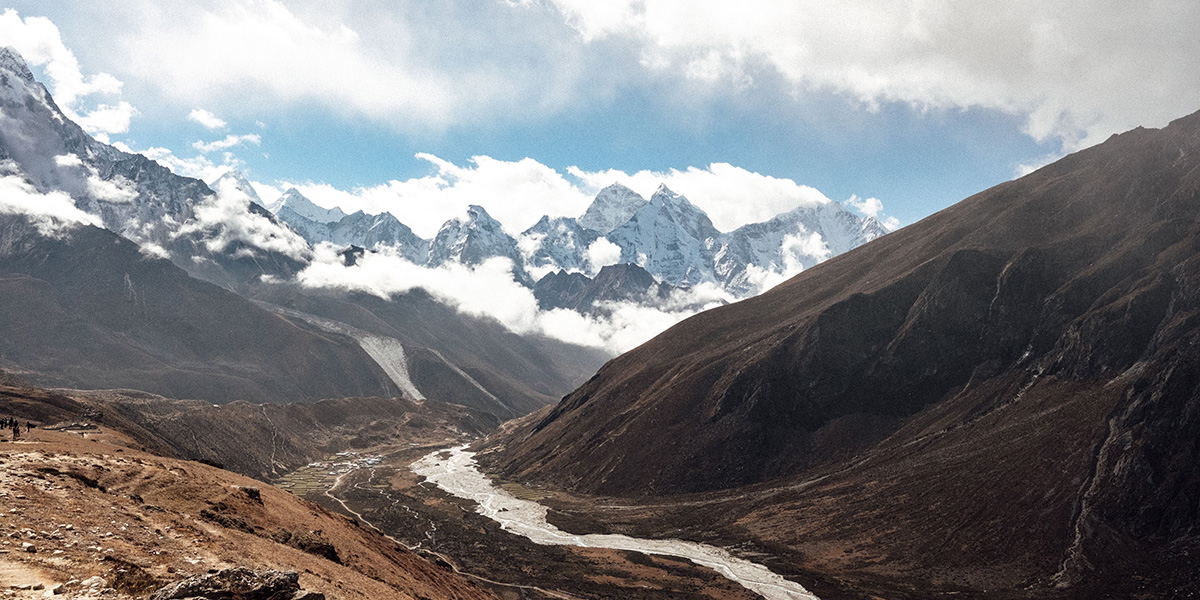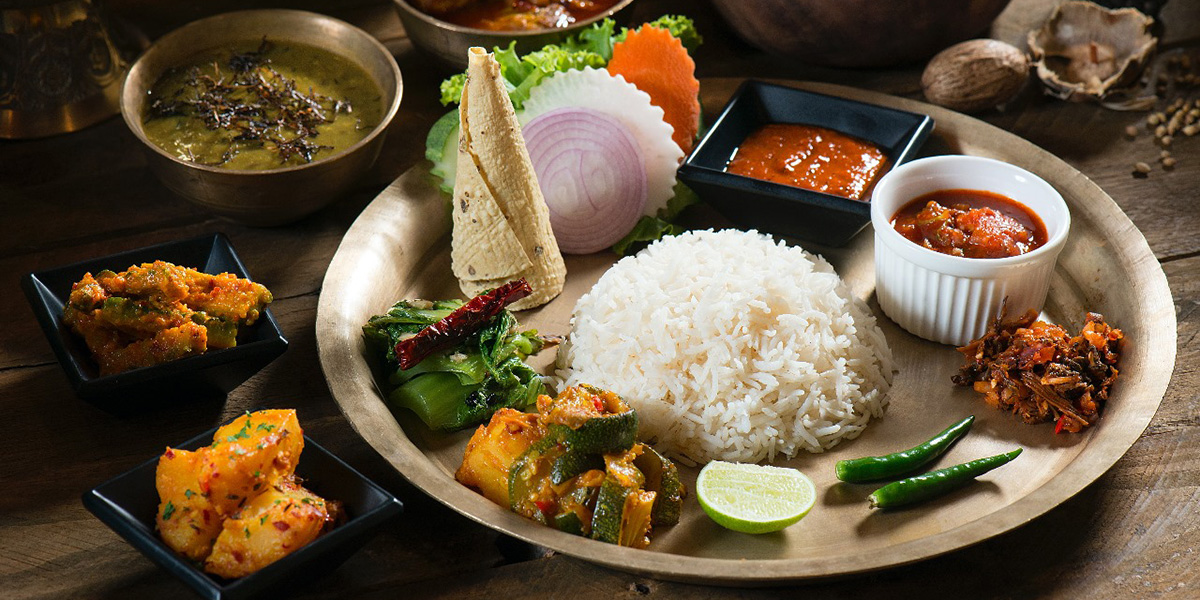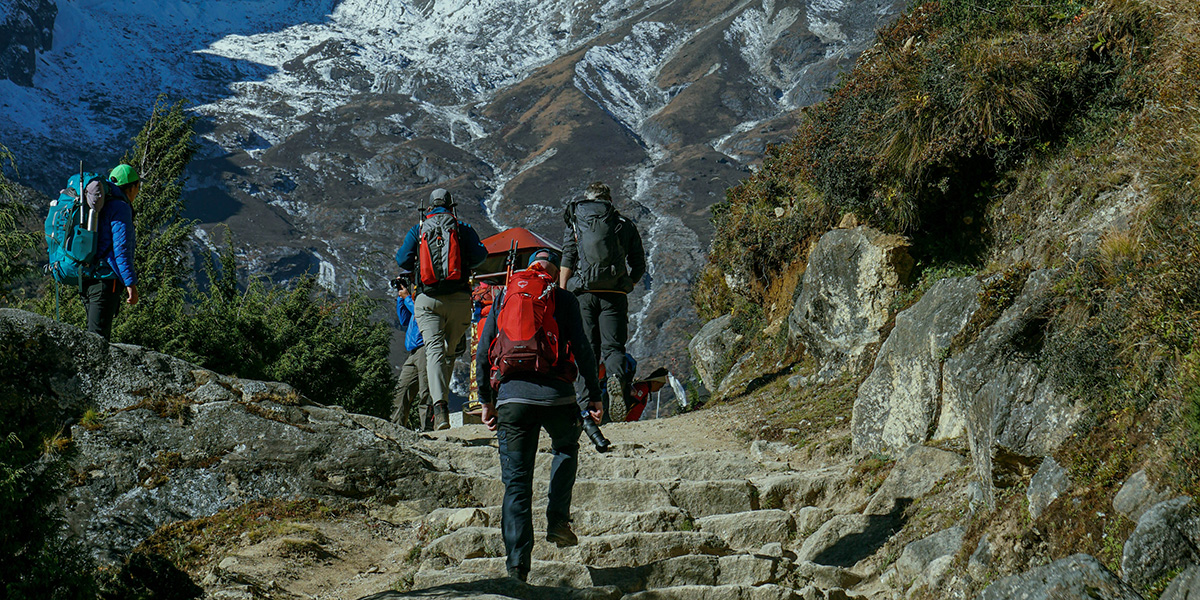- AddressG21b, The Pier, Pier Point Road, Cairns QLD 4870 Australia

1700 kilometers. 150 days. And 6000 meters. These numbers are only for an extraordinary adventure, and that’s the Great Himalayan Trail (GHT) in Nepal. Spanning 1,700 kilometers over 150 days and reaching an elevation above 6000 meters, the Great Himalayan Trail in Nepal is unlike any other adventure. The GHT Nepal is one of the longest and highest trekking trails in the world. Few adventurers from across the world have achieved this feat, and the number is notably scarce. According to the statistics by Himalayan Adventure Labs, only 104 hikers have completed the GHT until March 2023. While numerous attempts were made, many experienced trekkers faced challenges and fell short of the trail’s demanding journey. That’s why we said it is an extreme adventure.
This trail was proposed and formulated by the trailblazer Robin Boustead from Australia. Since the early 2000s, many trekkers have been exploring its various sections. The GHT has a longer version, stretching 4,500km and connecting five Asian countries: Nepal, India, China, Pakistan, and Bhutan. However, it’s important to note that this ambitious trail remains a work in progress. Let’s focus on the Nepal GHT. If the above numbers seem intimidating, you can do one or two of the 10 sections of the GHT, each doable in a few weeks or months. We will discuss all the sections, including the best time, difficulty level, routes, and every essential aspect.
Length (Nepal): 1,700 kilometers (621 miles)
Duration: 150+ days
Number of sections: 10
Routes: Low route (cultural route) and high route (mountain route)
Difficulty: Extremely challenging
Maximum Altitude: 6,200 meters (20,341 feet)
Hazards: Severe weather, altitude sickness, remoteness
Accommodations: teahouses and camping
Permits: varying by sections
Shortest Section: Langtang (around 18 days)
Longest Section: Makalu to Everest (around 35 days)

The Great Himalayan Trail is not for the faint of heart. Let us highlight this: ‘not for the faint of hearts.’ That’s because of 4000 people who have climbed Everest, only one has completed the GHT. Yep, you read it right. Just 1. In all these years, since the early 2000s, only around 100 people have completed the trail. Now, imagine having to secure six months off and some tens of thousands of dollars. It takes a whole lot of determination, commitment, and perseverance to do this adventure. It’s an extreme trekking trail, demanding over 150 days with more than 150,000 meters of climbing and descending through the remotest peaks of the Great Himalayas range.
The Great Himalayan Trail poses significant challenges due to its extreme altitudes, unpredictable weather, rugged terrains, and varying climates. It requires trekkers to navigate diverse landscapes, high mountain passes, and remote regions, making it a demanding and physically taxing expedition. Even Wikipedia has labeled its difficulty strenuous. There are hardly any difficult thru-hikes that exist other than the GHT. In short, this adventure is extremely hard to complete.
The Great Himalayan Trail (GHT) duration can vary significantly based on various factors, including the specific section or sections chosen, individual trekking pace, weather conditions, and acclimatization needs. Some may opt for a thru-hike, attempting to cover the entire trail in one continuous journey, while others might choose a more gradual approach, taking breaks between sections and extending their trek over a few years. If you want to complete in the first go, it should take around 150 days. Let’s look at some stats.
In 1994, Paul-Eric Bonneau of France (along with Bruno Poirier) started this on October 21, 1994, and successfully completed it on December 1, 1994, taking a total of 42 days, setting a record as the fastest completion to date. Paul’s trek was initiated from Pashupatinagar and concluded at Mahakali. The latest record was of Abdoreza Kouhpayeh from Iran, who started on March 25, 2023, and completed on July 2, 2023, taking a total of 100 days. The maximum number of days recorded is 220 days, by Ivan Roslyakov from Russia in 2012, with completion in 2017. So, yeah, the duration of the GHT totally depends on your trekking pace, preference, and weather conditions. You may complete the GHT in just 45 days, or it could take you a few years.
It is 1700 kilometers of tracks, stretching across east to west of Nepal Himalaya. The official length of the GHT is 1700 kilometer, but it can vary depending on the route chosen. Arguably, this is one of the longest and most challenging trekking routes in the world. This trail covers 16 districts, from the far east in the Kanchenjunga region to the high plateaus on the Tibetan borderlands in the far west, with a network of 10 treks beyond the world-famous Everest Base Camp Trek and the Annapurna Circuit Trek. The trail traverses the country’s high mountain passes like Larkya La (5,106m), Tilman Pass (5,320m), and Sherpani Col (6,097m).

The Great Himalayan Trail (GHT) has 10 sections based on different regions of the Himalaya. Below are the manageable sections from east to the west of Nepal:
The Kanchenjunga region, forming the eastern section of the GHT, boasts the third-highest mountain in the world. At a staggering height of 8,568m (28,110 ft), Kanchenjunga beckons elite climbers and avid adventurers to its base camp. Located in the far east of Nepal and bordering Sikkim, this region remains one of the least visited regions in Nepal. The famous trek in this region is the Kanchenjunga Base Camp trek. The challenging trek to the Kanchenjunga Base Camp is among the underrated treks in Nepal.
Makalu Barun, in eastern Nepal, is a secluded region that is somehow not-so-popular as the Everest or Annapurna region. Makalu Barun is home to Makalu at 8,485m, the 5th highest mountain in the world. The trekking trails in Makalu Barun offer adventurers a rare opportunity to explore the untouched wilderness, cross challenging terrains, and encounter remote villages along the way. The trek to Makalu Base Camp is considered one of the toughest treks in the Himalayas of Nepal. This region lets you cross three cols- East Col (6,146m), West Col (6,143m), and Amphu Labsta (5,848m).

Everest region, the crown jewel of the Great Himalayan Trail, is the most popular trekking region in Nepal. Home to the world’s highest peak, Mount Everest, this region attracts hundreds of thousands of trekkers and climbers alike from across the globe. Adjacent to the Everest region is the lesser-explored Rolwaling region, characterized by its remote and challenging trails. Rolwaling region, home to Gaurishankar Mountain, offers the popular short trek called the Tsho Rolpa Lake trek. This section of the GHT lets you marvel at the three highest peaks in the world- Everest, Lhotse, and Cho Oyu.
Langtang and Helambu section of the GHT are well-known trekking regions in Nepal with popular trekking trails like Langtang Valley Trek, Helambu Trek, Gosaikunda Trek, and Ganja La Pass Trek. Langtang and Helambu regions, situated in the central part of Nepal, are more accessible and reward unforgettable trekking experiences. These regions are indirectly connected with Everest and Rolwaling areas, forming a trail network. Helambu region can connect with the Everest region, and likewise, trekkers can explore the Rolwaling region from Gosaikunda area.
The Manaslu and Ganesh Himal region joins the Langtang and Helambu section in the west. This section of the GHT lets trekkers circumnavigate the eighth-highest peak in the world, Mount Manaslu. The trails in these regions are moderately difficult but equally rewarding. The trail offers stunning views of the Manaslu range and surrounding peaks, making it a sought-after destination for those seeking a more remote and less-crowded trekking experience. The trek along this route crosses Larkya La Pass, the highest point in the Manaslu Circuit trek. The treks in this region are moderate and ideal for both novice and experienced trekkers.

Arguably, the Annapurna and Mustang regions are the most popular trekking regions in Nepal. The Annapurna Circuit, a classic trek in the Annapurna region, and the Upper Mustang trek in the Mustang region are two of the most sought-after treks in Nepal. And there are more. The region also boasts the Annapurna Base Camp trek. Adjacent to Annapurna, the Mustang region unfolds as a mystical and arid landscape, often referred to as a “Hidden Kingdom.” Hundreds of thousands of trekkers flock to these regions every year to experience the unparalleled beauty of the Annapurna and Mustang regions.
Dolpo region, situated in the northwestern part of Nepal, is among the lesser-explored regions of the GHT. Dolpo region is home to Shey Phoksundo National Park and Phoksunda Lake, the deepest lake in Nepal. The Dolpo trek takes trekkers through ancient Bon monasteries, traditional villages, and arid landscapes. Very few trekkers make their way to the Dolpo region in Nepal due to the isolation and its remote and challenging nature. Additionally, Dolpo’s status as a restricted area necessitates special permits, contributing to the exclusivity of the region.
The Rara and Jumla section of the GHT takes trekkers to the Rara National Park and Jumla district of Nepal, which are comparatively less explored and offer a serene escape into the remote corners of the Himalayas. The region’s untouched beauty and the tranquil ambiance of Rara Lake make it a hidden gem. Compared to the Everest, Annapurna and Langtang section, this section is quite unexplored. The hike to Jumla is not so popular and is often considered a difficult one and takes around 30 days from Kathmandu.
Humla is perched in the far-western reaches of Nepal, close to the Tibetan border. Very few adventurers venture into this region of Nepal. The Humla section typically begins from the Simikot village and involves crossing mountain passes and navigating through remote villages. Humla, a culturally fascinating place, is the gateway to the sacred Mt. Kailash. For those who have never been to the far-western part of Nepal, this trek will serve as a testament to the spirit of exploration.

Far-West Nepal is the least explored areas of Nepal, consisting of a developmentally challenged part of Nepal. It’s quite challenging to trek to this part of Nepal for many reasons. There are limited treks to this part of Nepal due to isolation, challenges due to topography and limited infrastructures. The raw authenticity and untamed beauty of this region are what lure intrepid travelers. The trek to the far-west Nepal serves as the conclusion of the GHT.
The Great Himalayan Trail has two routes: the high route and the low route. The high routes are often referred to as the mountain route and the low routes as cultural route. As the name suggests, the low route winds through lower altitudes, and just like that, the high route leads through high altitudes. The low route passes the foothills of the Himalayas, while the high route covers high mountain passes. The city’s interlinked hiking trail is a solid example of a low route. These routes are comparatively easier and more accessible, not to mention inexpensive. This is because the trekkers don’t have to buy permits or mandatory guides. In terms of difficulty, it’s easier than the high routes. For easy understanding, here’s the difference between the two.
| Low Route | Aspect | High Route |
| 1000 to 3000 meters (3,000 to 10,000 ft) | Altitude Range | Above 4000 meters (13,000 ft) |
| Terrain challenges, river crossing and variable weather | Challenges | Altitude sickness, high-altitude landscape, reduced oxygen level, technical climbing |
| Takes less time | Duration | Typically longer due to challenging terrain and acclimatization |
| Views of lower peaks | Peaks | Stunning views of some of the world’s highest peak |
| Lush forests, valleys and hills | Ecosystem | Alpine environments, snow-clad landscapes |
| Possibly year-round | Best Time | Spring and autumn |
| Easy access to trailheads and more accessible from major towns | Access and logistic | Remote trailheads, teahouses |
| Usually not required | Permits | Required to enter national parks and restricted areas. |

Trekkers generally have two accommodation options: teahouse and camping. In well-established trekking regions like the Annapurna and Everest sections, teahouses and lodges dot the trails, providing trekkers with basic yet comfortable amenities. A typical tea house provides all the basic amenities needed for a trekker for a comfortable stay. These accommodations usually consist of simple rooms with twin beds, basic bedding, and shared bathroom facilities. Dining areas in the tea houses serve a variety of meals, including both local and international dishes.
In remote areas where there are fewer facilities and are hardly accessible, tents and homestays become common feature. Homestay is a great opportunity to stay and interact with local families and gain firsthand insight into their daily lifestyle and traditions. Camping becomes priority in areas with no teahouses and minimal infrastructure. The least-explored sections and topographically challenged areas of Nepal have the only camping option.
The food menu of most teahouses generally includes a mix of local and international dishes, ranging from everyone’s favorite Nepali dal bhat (rice and lentils) to pasta, noodles, soups, and hearty breakfast options. Food items like dal bhat, noodles, vegetables, and meat (chicken) are staples and readily available. Nepali cuisine includes dal bhat, momos, gundruk, and local soup. You may find pasta, pizza, and other international cuisines in developed areas. As far as camping is concerned, if you are organizing this adventure from a tour operator, they have a predefined set of meals, commonly comprising the following.
Here’s the list of permits required for the GHT, based on the sections:
| Section | Permits |
| Kanchenjunga region | · Kanchenjunga Conservation Area Project Entry Permit (KCAP)
· Kanchenjunga Restricted Area Entry Permit (RAP) |
| Manaslu region | · Trekker’s Information Management Systems (TIMS) Card
· Makalu Barun National Park Entry Permit |
| Everest region | · Sagarmatha National Park Entrance Fee
· Pasang Lhamu Rural Municipality Local Entry Permit |
| Rolwaling region | · Gaurishankar Conservation Area Project Entry Permit
· Dolakha Lama Bagar Restricted Area Entry Permit |
| Langtang and Helambu region | · Langtang National Park Entry Permit
· Trekker’s Information Management System (TIMS) Card |
| Manaslu and Ganesh Himal Region | · Manaslu Restricted Area Entry Permit
· Manaslu Conservation Area Project Entry Permit |
| Annapurna region | · Annapurna Conservation Area Project Entry Permit
· Trekker’s Information Management System (TIMS) Card |
| Mustang region | · Annapurna Conservation Area Project Entry Permit
· Restricted Area Entry Permit for Upper Mustang |
| Dolpo region | · Shey Phoksundo National Park Entry Permit
· Rara National Park Entry Permit · Restricted Area Entry Permit for Dolpo |
| Humla | · Restricted Area Entry Permit for Simikot |

First things first, take 6 months off! You gotta seriously prepare for this adventure, the adventure of a lifetime. You will be bagging exclusive bragging rights! This requires a meticulous preparation process, careful consideration, and planning that is as intricate as the GHT itself. Six months prior to the trek, you should engage in a dedicated fitness regimen focusing on cardiovascular endurance, and strength training. This proactive approach helps build the stamina required for sustained trekking across diverse terrains and varying altitudes.
Financial planning should be a top priority. You will be spending tens of thousands. You must establish a realistic budget that entails allocating money for contingencies as well. You are advised to research and develop a detailed itinerary and gain some insights. If you are thinking of doing the GHT on your own, we suggest you drop the idea because it’s extremely challenging and almost impossible. Everything from logistics to food resupplies and navigation is a significant challenge. We hate to spill the beans, but most hikers often quit the Great Himalayan Trail. And this could be the reason why only around 100 people have completed the trail till now.
The best time to do the GHT depends on the specific section you plan to explore. The GHT spans a vast range of elevations and climates, from subtropical to high alpine zones. However, spring and autumn are considered the ideal time of the year to start this adventure. The best months are March, April, May, June, September, October, and November. These periods offer clear skies, balmy weather, and excellent visibility of the majestic mountains. While autumn offers cooler temperatures and cleaner air following the monsoon, making it a popular destination for hiking, spring brings flowering flowers and a somewhat milder climate.
Please note that you can also trek during off-seasons (winter or monsoon), which has its drawbacks and challenges, particularly cold weather, heavy rainfall, and limited services along the route. If you are doing the low route, you can do the trek throughout the year. For high routes, make sure to schedule your trek during spring and autumn for optimal trekking experience.

Here’s the ultimate packing list for the GHT: